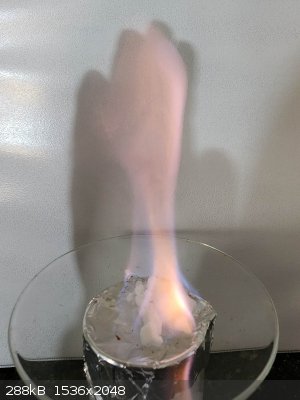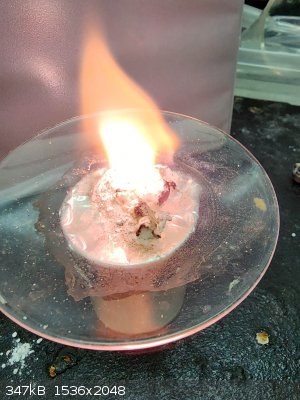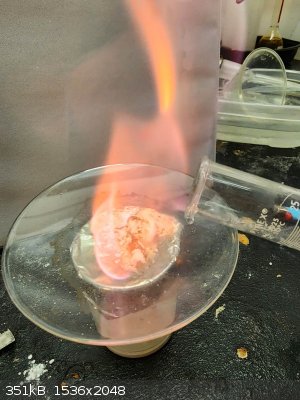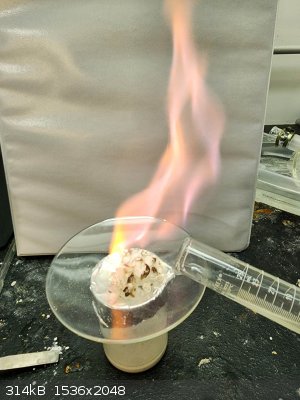| Pages:
1
2 |
ave369
Eastern European Lady of Mad Science
   
Posts: 596
Registered: 8-7-2015
Location: No Location
Member Is Offline
Mood: No Mood
|
|
It was I who mentioned pH 4, in a wholly different context.
Smells like ammonia....
|
|
|
Alkoholvergiftung
Hazard to Others
  
Posts: 151
Registered: 12-7-2018
Member Is Offline
|
|
Is it Guanidinnitrate? Solubility like KNO3, Burns without remanents. Bad Solutions would be over ph 7.
|
|
|
Gammatron
Hazard to Others
  
Posts: 125
Registered: 30-8-2022
Location: Abandoned Uranium Mines
Member Is Offline
|
|
The distillate just turns out to be dilute H2SO4, boiling around 150C, it slowly attacks copper while hot but adding NaNO3 accelerates the attack and
releases NO2. As I expected, the powder never reacted with the acid and instead that is what I was actually distilling over. I added a little water to
help with the foaming so thats why it is dilute.
The powder is not affected by HCl, ~40% HF acid, 40% acetic acid or 10% NH4OH.
It will be difficult to measure density because when added to water, about half of it floats and the rest of it seems like it has air trapped in it...
But now that I think of it, it does go right into ethanol without trapping any air so I could just measure it with that.
Edit: that didn't work at all. I thought I could adjust for the density difference of using alcohol instead of water but im also not the greatest at
math, maybe someone else can figure it out.
Measured density of alcohol: 0.78g/ml
Flask size: 25ml
Flask weight: 49.94g
Powder added: 0.84g
Alochol to fill to 25ml: 19.24g
Guanidine nitrate is flammable and an explosive in itself according to wiki and this is not.
[Edited on 3-25-2023 by Gammatron]
|
|
|
Rainwater
National Hazard
   
Posts: 799
Registered: 22-12-2021
Member Is Offline
Mood: indisposition to activity
|
|
barium thiosulfate doesnt react with any of those chemicals
This post
http://www.sciencemadness.org/talk/viewthread.php?tid=152049
List a paper which describes how to test for the thiosulphate ion using reagents of iron, copper and nitric acid
| Quote: | Reaction of iron(III) with Thiasulfate
Prepare some Fe(NO3)3(aq)-a few tenths molar-and put some into each of three beakers. Prepare some
Na2S203(aq)--a few tenths
molar; also prepare some Cu(N03)2(aq)-a few tenths molar-in a
smalI bottle with a medicine-dropper top. Add a small amount of
Na2S203(aq) to one of the beakers containing Fe3+(aq). The solution
will immediately turn a deep violet color. During the next few
minutes the violet color will gradually fade away and the color will
return to that characteristic of Fe3+(aq). Next add a small amount of
Na2S2O3(aq) to each of the remaining two beakers containing
Fe3+(aq). To one of the beakers add a few drops of Cu(N03)2(aq).
The violet color in the solution containing the Cu2+(aq) catalyst will
fade very rapidly, whereas the violet color in the uncatalyzed solution
will again take several minutes to fade away. |
That did not coppy well from the pdf.
By replaceing the sodium thiosulphate(Na2S2O3 with the unknown, any result would be something.
Edit: fixed the bad copy
[Edited on 25-3-2023 by Rainwater]
0.84÷(0.78×25−19.24) = 3.2307692308 g=cm³
https://m.chemicalbook.com/ChemicalProductProperty_EN_CB8131...
Density of BaS2O3 3.45 g/cm³
Decomposition temp 220c
Melting point 220c
Sounds like a good candidate to me. Pricey stuff to
[Edited on 25-3-2023 by Rainwater]
"You can't do that" - challenge accepted
|
|
|
Gammatron
Hazard to Others
  
Posts: 125
Registered: 30-8-2022
Location: Abandoned Uranium Mines
Member Is Offline
|
|
I dont have time to do another test right now, going to meet up with Dr. Bob to get some lab supplies 
However, it doesnt seem very likely it would be a barium compound because as far as I can tell they are somewhat uncommon and expensive. I think I got
like 10lbs of this stuff for $30 or somewhere around that neighborhood. I bought it so long ago and just never even did anything with it until now. I
wish I could contact the seller but I don't see the listing on ebay anymore. I'm starting to think this is going to require the help of a mass
spectrometer lol
|
|
|
ave369
Eastern European Lady of Mad Science
   
Posts: 596
Registered: 8-7-2015
Location: No Location
Member Is Offline
Mood: No Mood
|
|
What about the rerun of the MnO2 test with proper timing? The fact that the distillate was confirmed to be just sulfuric acid speaks in favor of the
persulfate hypothesis.
Smells like ammonia....
|
|
|
Texium
Administrator
       
Posts: 4515
Registered: 11-1-2014
Location: Salt Lake City
Member Is Offline
Mood: PhD candidate!
|
|
Barium salts also generally give a quite strong lime green flame test, so it’s unlikely to be the case given that you didn’t observe that (and
luckily for you too, considering you tasted it, given that barium is highly toxic…) They aren’t all that uncommon or expensive, though, and they
are commonly used in pyrotechnics to impart a green flame color.
|
|
|
Gammatron
Hazard to Others
  
Posts: 125
Registered: 30-8-2022
Location: Abandoned Uranium Mines
Member Is Offline
|
|
Oh yeah, I did try the MnO2 test again for several minutes and there was no change in ph.
well, the few times ive looked for them on eBay they were quite expensive but they were also high purity samples.
I gave some of the powder to Dr. Bob to run through his mass spectrometer at work. He wasn't sure if his machines would be calibrated correctly to
detect such a compound but he said he could give it a try. I'm running out of chemicals to test this against and it just blows my mind that it wont
react with anything except to burn with sugar and explode in flash powder and even if I never figure out what it is, it is at least useful for that
lol
|
|
|
clearly_not_atara
International Hazard
    
Posts: 2694
Registered: 3-11-2013
Member Is Offline
Mood: Big
|
|
More importantly, BaO2 reacts readily with sulfuric acid. We are narrowed down to a very short list of compounds based on oxidizer + does not react
easily with sulfuric acid. And yellow fumes, which to me sounded like chlorine. And it is almost entirely volatile.
One test that seems tempting is to reduce it with formic acid and analyze the residue. If any. What a strange compound.
[Edited on 04-20-1969 by clearly_not_atara]
|
|
|
ave369
Eastern European Lady of Mad Science
   
Posts: 596
Registered: 8-7-2015
Location: No Location
Member Is Offline
Mood: No Mood
|
|
Sounds like a pretty good idea to me. If it's an oxidizer, try various reducing agents at various pH.
Smells like ammonia....
|
|
|
Gammatron
Hazard to Others
  
Posts: 125
Registered: 30-8-2022
Location: Abandoned Uranium Mines
Member Is Offline
|
|
Just going to post my current update, I haven't tried changing the ph with any of the solutions below but it has no reaction with any of them.
Oxalic acid, K dichromate, NaBr, KI, H2O2, NaF
Now I haven't been very scientific with any of these and have just dissolved a random amount in water and added a tiny spoonful of the powder, I also
didn't let them sit for very long but if it was going to react then I would expect to see something immediately. But there hasn't been the slightest
hint of a reaction with anything I've tried and im running out of new things lol
HOWEVER! I mixed a little with some ground up charcoal and it was sparking like it wanted to burn but went out. So I added a little more as well as a
little sulfur and it went up in bright flame with tons of smoke, just like black powder! The smoke had almost a slight sting in the nose when inhaled
as if there was some Cl or SO2 in it but it was too faint to make any guess. It could have just been from the sulfur I added. So I also tried burning
soaked with alcohol and I was finally able to get some good pictures of the purple flame and also found that once most of the alcohol has burned away
and the powder can heat up to decomposition it greatly accelerates the burning within that chunk of material until its gone, but it does not spread.
[Edited on 3-25-2023 by Gammatron]
|
|
|
Gammatron
Hazard to Others
  
Posts: 125
Registered: 30-8-2022
Location: Abandoned Uranium Mines
Member Is Offline
|
|
Firstly, the colors are much more vivid in person but still clearly seen in the pictures. The picture where the flame is small and bright is what I
meant when it accelerates the burning near the end. It also gets some yellow and orange color in it but I can't be sure if where thats from, possibly
contamination or maybe it has some Na in it? It only appears when the powder starts getting hot.
edit: did some more flame tests, I tried dumping dry powder on the burning alcohol and the clumps would melt into little beads that burned with
spectacular and powerful flames even though all the fuel was in the form of alcohol vapors external to the powder.
   
[Edited on 3-25-2023 by Gammatron]
|
|
|
Texium
Administrator
       
Posts: 4515
Registered: 11-1-2014
Location: Salt Lake City
Member Is Offline
Mood: PhD candidate!
|
|
That does look like a potassium flame.
|
|
|
Gammatron
Hazard to Others
  
Posts: 125
Registered: 30-8-2022
Location: Abandoned Uranium Mines
Member Is Offline
|
|
A little more interesting finds, when mixed 50/50 with either sulfur or carbon then it will explode with a strong impact (both mixtures were about the
same in power), I was unable to set it off by itself. Id say its about 10% as powerful as ETN by weight just based on the sound but obviously thats
very subjective. The flash powder with Al and S is probably 2 or 3x more powerful than with the S or C mixtures.
Burning with the sulfur mixture looked like regular burning sulfur until it was hot enough to decomp the powder at which point the whole pile went up
in a blinding blue flame. The carbon mixture lit a little more easily and burned with an equally bright white flame. (I added more Ox than the
previous test I tried with carbon)
At this point with these results Im kinda glad I received this mysterious powder instead of KNO3 cause its a lot more fun to play with 
[Edited on 3-26-2023 by Gammatron]
|
|
|
fusso
International Hazard
    
Posts: 1922
Registered: 23-6-2017
Location: 4 ∥ universes ahead of you
Member Is Offline
|
|
Could it be a mixture mostly of something volatile with a little K?
|
|
|
Herr Haber
International Hazard
    
Posts: 1236
Registered: 29-1-2016
Member Is Offline
Mood: No Mood
|
|
The suspense is killing me 
Among all the properties you described, it's the "water repellent" aspect that puzzles me the most.
The spirit of adventure was upon me. Having nitric acid and copper, I had only to learn what the words 'act upon' meant. - Ira Remsen
|
|
|
Gammatron
Hazard to Others
  
Posts: 125
Registered: 30-8-2022
Location: Abandoned Uranium Mines
Member Is Offline
|
|
For me its the unreactiveness to literally everything unless burned or hit with a hammer, it just doesn't make sense to me. I also suspect that the
hydrophobicity might be hindering it from reacting to certain solutions but I figured I'd at least see some indication that somethings happening.
|
|
|
ave369
Eastern European Lady of Mad Science
   
Posts: 596
Registered: 8-7-2015
Location: No Location
Member Is Offline
Mood: No Mood
|
|
You did mention is dissolves a little bit when water is heated to boiling temp. Why not try reactions with reducers at boiling temp?
Smells like ammonia....
|
|
|
ave369
Eastern European Lady of Mad Science
   
Posts: 596
Registered: 8-7-2015
Location: No Location
Member Is Offline
Mood: No Mood
|
|
The mystery remains...
Smells like ammonia....
|
|
|
Rainwater
National Hazard
   
Posts: 799
Registered: 22-12-2021
Member Is Offline
Mood: indisposition to activity
|
|
Any updates?
"You can't do that" - challenge accepted
|
|
|
| Pages:
1
2 |